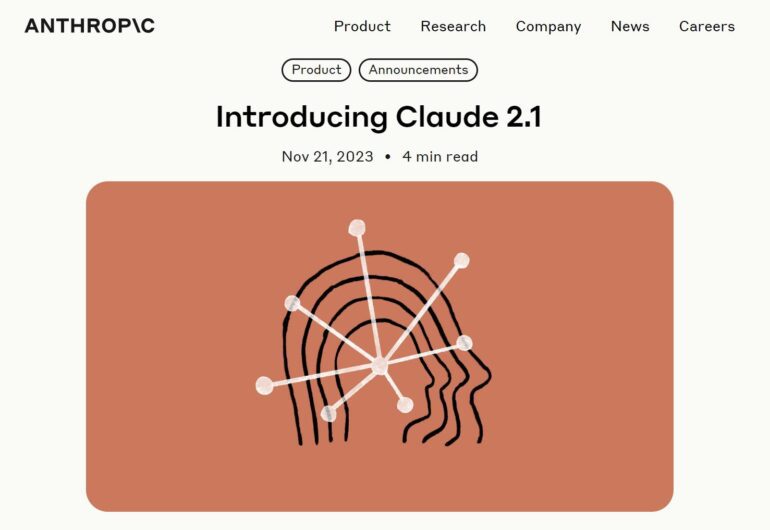TL;DR:
- Anthropic lowers per-token pricing for Claude 2.1 in response to increased competition.
- Open-source AI alternatives challenge closed-source models in the market.
- The move aims to retain enterprise clients and solidify Anthropic’s position.
- Open-source AI offers greater customization potential at lower costs.
- Enterprises can cut costs significantly with open-source AI.
- Open source proliferation poses a threat to closed-source vendors.
- Agility is crucial for maintaining AI leadership in a competitive landscape.
Main AI News:
In the fast-evolving landscape of conversational artificial intelligence (AI), Anthropic, a trailblazing AI model laboratory, has made a strategic move to maintain its competitive edge. With the emergence of formidable players and the surge of open-source alternatives, Anthropic has chosen to lower the per-token pricing of its renowned conversational model, Claude 2.1. This decision is not only a response to market pressures but also a reflection of Anthropic’s commitment to its growing enterprise clientele.
The CEO and co-founder of OthersideAI, Matt Shumer, recognizes the intensifying competition in the AI arena. He notes, “As more players have entered the market, it’s just accelerated things.” Players like DeepMind have exerted pressure on closed-source large language model (LLM) firms, including OpenAI and Anthropic, compelling them to drive down costs continually.
However, Shumer believes that the true challenge lies in the proliferation of open-source solutions. Models like Mistral and Poro are democratizing access to sophisticated AI, allowing companies to avoid relying on a single vendor. This expanding landscape provides businesses with the flexibility to choose from a multitude of options, each offering unique advantages.
Anthropic’s decision to reduce Claude’s per-token rates is a strategic move aimed at retaining its growing base of enterprise customers invested in conversational AI applications. By offering Claude at a more competitive price point compared to its rivals, such as OpenAI, Anthropic seeks to solidify its position in a maturing market with increasingly discerning standards of value.
Unlocking Customization Potential with Open Source
While affordable pricing widens access to AI, open-source alternatives offer even greater customization potential. Shumer emphasizes, “With open AI, they are optimizing for the average use case…we could think about constructing our systems and our servers differently so that they’re much more optimized for that.”
Open-source models empower companies to tailor their infrastructure precisely to their unique requirements, resulting in significantly lower costs compared to generalized closed APIs. Shumer estimates that open-source tools can deliver intelligence “orders of magnitude cheaper” through such customized optimization.
For enterprises already investing in AI, open source presents an enticing value proposition. Shumer explains, “If you can cut those costs by 10-20x, and you’re a larger company…you’re going to do so.” The ability to have complete ownership of one’s AI stack presents a compelling case for ambitious firms seeking a competitive edge.
As a result, the proliferation of open source poses a distinct future challenge for closed vendors. Shumer frames it as follows: “I actually see open source proliferation as the more imminent threat to these companies.” Pioneering firms risk not only losing customers but also top technical talent drawn to open opportunities that unlock greater potential.
Anthropic’s Strategic Response
This dynamic landscape informed Anthropic’s decision to competitively lower Claude’s per-token rates. Maintaining a strong foothold in an increasingly price-sensitive and tech-savvy market demands continuous responsiveness to the open-source alternative. Closed vendors must tread carefully, balancing affordability with the necessity of proprietary business models.
Navigating the Shifting Sands of AI Leadership
To maintain leadership in the conversational AI sector, agility in navigating market shifts is imperative. Early incumbents like OpenAI were pioneers in the field but now face disruptions from newer, agile companies. Shumer observes, “A year ago, two years ago…it was just OpenAI. Now, there are many players competing.”
Greater competition fosters innovation as multiple stakeholders drive progress. According to Shumer, “That’s going to drive the prices down…drive the capabilities up because more people are trying to build the same thing.” This rapid evolution presents both challenges and opportunities for enterprise AI adoption plans.
However, OpenAI’s struggles also shed light on the advantages of the growing open-source landscape. Unlike proprietary systems reliant on single vendors, open models distribute responsibility across wider communities. Despite past uncertainties, the industry is evolving.
Success in this evolving landscape favors companies that demonstrate flexibility in responding to emerging alternatives. As the conversation illustrated, even established firms are testing both proprietary and open-source approaches depending on specific tasks. Finding the optimal balance positions organizations for ongoing affordability and technical leadership.
Above all, AI leadership now demands proactive monitoring of a diversifying landscape of options. Embracing change and adapting to new models of value empowered by open source will provide decisive long-term advantages in this ever-evolving AI landscape.
Conclusion:
Anthropic’s decision to lower pricing for Claude 2.1 reflects the intensifying competition in the AI market, driven by open source alternatives and the need for affordability. To maintain a leadership position, businesses in this sector must remain agile, responsive to market shifts, and open to exploring open source solutions. The AI market is evolving rapidly, with increased competition fostering innovation and driving down prices, offering both challenges and opportunities for companies in the space.

